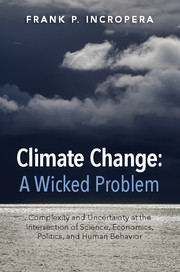 Climate Change: A Wicked Problem
Climate Change: A Wicked Problem Book contents
- Frontmatter
- Dedication
- Contents
- Foreword by Anthony F. Earley Jr.
- Foreword by G.P. “Bud” Peterson
- Foreword by Arun Majumdar
- Preface
- Acknowledgments
- Abbreviations
- 1 Energy, economics, and climate change
- 2 The Earth's climate system
- 3 Greenhouse gases
- 4 Global warming
- 5 Consequences of global warming
- 6 Mitigation, adaptation, and geoengineering
- 7 Public policy options
- 8 The politics of global warming: a history lesson and future prospects
- 9 Dissenting opinions: the great hoax
- 10 The ethics of climate change
- 11 A way forward
- Appendix A Units and conversion factors
- Appendix B Fossil fuels
- Appendix C Anthropogenic sources of natural gas and methane
- Appendix D Environmental time scales and inertia
- Appendix E Coal-fired power plants: operating conditions and costs of carbon capture and sequestration
- Notes
- References
- Index
- Plate section
8 - The politics of global warming: a history lesson and future prospects
Published online by Cambridge University Press: 05 October 2015
- Frontmatter
- Dedication
- Contents
- Foreword by Anthony F. Earley Jr.
- Foreword by G.P. “Bud” Peterson
- Foreword by Arun Majumdar
- Preface
- Acknowledgments
- Abbreviations
- 1 Energy, economics, and climate change
- 2 The Earth's climate system
- 3 Greenhouse gases
- 4 Global warming
- 5 Consequences of global warming
- 6 Mitigation, adaptation, and geoengineering
- 7 Public policy options
- 8 The politics of global warming: a history lesson and future prospects
- 9 Dissenting opinions: the great hoax
- 10 The ethics of climate change
- 11 A way forward
- Appendix A Units and conversion factors
- Appendix B Fossil fuels
- Appendix C Anthropogenic sources of natural gas and methane
- Appendix D Environmental time scales and inertia
- Appendix E Coal-fired power plants: operating conditions and costs of carbon capture and sequestration
- Notes
- References
- Index
- Plate section
Summary
Consider the atmosphere from any point on the Earth's surface. Move east, west, north, or south; the atmosphere has no boundaries. If a CO2 molecule is discharged from a point source in the United States, it can move in any direction, and one year hence it could be over India, Brazil, or anywhere else in the world. Likewise, GHG emissions in India and other nations make their way to the United States and to every other nation. All nations contribute to GHG emissions, some more than others, and all nations are recipients of the emissions. Geographically, the atmosphere is nondiscriminatory.
To the extent that GHG emissions contribute to global warming and, in turn, warming contributes to climate change, inherent problems are not local, regional, or national. They are transnational. The problems cannot be solved by any one nation – although some can contribute more than others – but must be addressed by collaboration among all nations. Even the smallest of nations that contribute little to GHG emissions must be involved, for they may well be among those most adversely impacted by climate change and least able to adapt.
Whether the problem is perceived as potential or omnipresent, the fact that it is international is indisputable. And the international community has been paying attention. In this chapter, we will examine efforts to address the problem and the mine fields that have impeded substantive progress. As applied to climate change, the chapter is a history lesson in geopolitics, highlighting how difficult it is to achieve consensus among nations of widely disparate cultures and economic conditions.
The Intergovernmental Panel on Climate Change
International agreements have long been used to address environmental issues for segments of the planet as diverse as the atmosphere, the open seas, and Antarctica. A relatively recent agreement is the Montreal Protocol of 1987, which calls for protection of the stratosphere's ozone layer through elimination of industrial chemicals termed chlorofluorocarbons (CFCs) and hydrochlorofluorocarbons (HCFCs).
Although interest in global warming can be traced to the late nineteenth century (Weart, 2003), it was not until 1988 that the issue began to receive serious attention.
- Type
- Chapter
- Information
- Climate Change: A Wicked ProblemComplexity and Uncertainty at the Intersection of Science, Economics, Politics, and Human Behavior, pp. 161 - 198Publisher: Cambridge University PressPrint publication year: 2015
